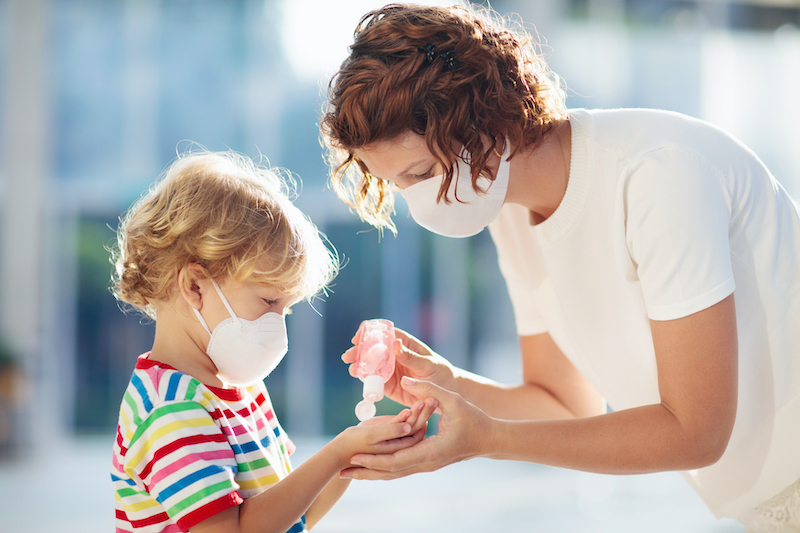COVID-19 Guide: Tips on How to Help Kids Wear Face Mask

While children are resilient and can be asymptomatic carriers of the coronavirus disease 2019 (COVID-19), teaching kids to wear masks is important so they can help protect others.
Making a Developmentally Appropriate Game Plan
It’s important for children to see proper face mask usage by their parents and older siblings. It is equally significant for them to be taught on their developmental level the appropriate reasons why wearing a face mask is important for their health and the health of others. Other healthy steps include:
-
Handwashing
-
Social distancing (you can even practice standing 6 feet apart at home!)
-
Covering with a face mask when you can’t social distance
-
Covering coughs and sneezes
-
Cleaning high-touch surfaces
-
Monitoring health (and staying home if sick)
General Tips for Talking with Children
Here are ways to talk and prepare kids for wearing a mask, as well as some practical tips — especially if your child is nervous about wearing a mask for the first time.
-
Remain Calm, Cool, and Collected: Children will often react to what we say because of how we say it.
-
Reassure Children: Children need to know that they are safe. It’s okay to feel upset and scared. Share how you as a parent/teacher are positively coping. Help them discover coping strategies best for them.
-
Be Available to Talk/Listen: Ensure that your children know that you are ready to listen and share when they want to talk. Provide truthful information on their level and only share enough that seems to satisfy their curiosity for the moment. They will return for more information, once you have a positive interaction the first time.
-
Avoid Blaming Language: Model respect through words and actions.
-
Be Mindful of Input: Monitor what children are seeing and hearing on television, radio, and online. Limit the amount of screen time, especially that is focused on COVID-19. Anxiety and stress can result from too much focus on any one topic. Encourage them to share what they have learned and ensure solid facts by researching together through reliable resources such as the Centers for Disease Control (CDC) and the American Academy of Pediatrics (AAP).
Five Tips for Properly Wearing Face Masks
-
Make sure to create a snug and comfortable fit against the side of the face, covering the nose.
-
Secure with ties or loops around the ears.
-
Wear a mask with several layers of fabric to provide best protection.
-
Ensure sensible breathability without any restrictions.
-
Sanitize masks when soiled or routinely, depending on the frequency of use. You may need more than one mask in case of sneezes! Always carry a sealable bag for the soiled mask and a fresh mask, just in case.
Safety Note: The American Academy of Pediatrics recommends not placing a face mask on any child under the age of 2, anyone who has trouble breathing, or is unconscious, incapacitated or otherwise unable to remove the cloth face covering without assistance.
How to Handle Your Child’s Fear of Face Masks
Wearing a face mask can be fun and a cool new idea, but some kids won’t take to their new accessory right away. Here are a few ways to help your kid become more comfortable with wearing a mask.
-
Show your child pictures of other children wearing face masks.
-
Allow your child to choose the fabric/characters on the face mask, add decorations to make them more personable and fun.
-
Incorporate a mirror with your child and wear your face mask and talk about it.
-
Get out the art supplies and each decorate a brown paper bag to store your masks.
-
Encourage them to place a face mask on a stuffed animal or favorite toy.
-
Purchase or create a second mask for a friend or stuffed animal. Parents could even facilitate for their child and their best friend to wear the same masks, then exchange photos.
-
Draw a face mask on their favorite book character in a coloring book or freestyle.
-
Practice wearing a face mask at home and then on a short outing in public, like the grocery store. Encourage waving as a new form of a non-verbal greeting, because no one can see our smiles in a mask.
-
Share a video from the CDC.gov website about wearing masks, such as: “COVID-19 Stop the Spread of Germs” and “What You Need to Know About Handwashing.” There are many other great YouTube videos for children, but it is important for parents to be prudent and preview prior to sharing with their children. You know your children best and can best discern appropriate viewing material.
Leslie Moore is an Emergency Department Specialty Nurse at Arkansas Children’s Hospital.
